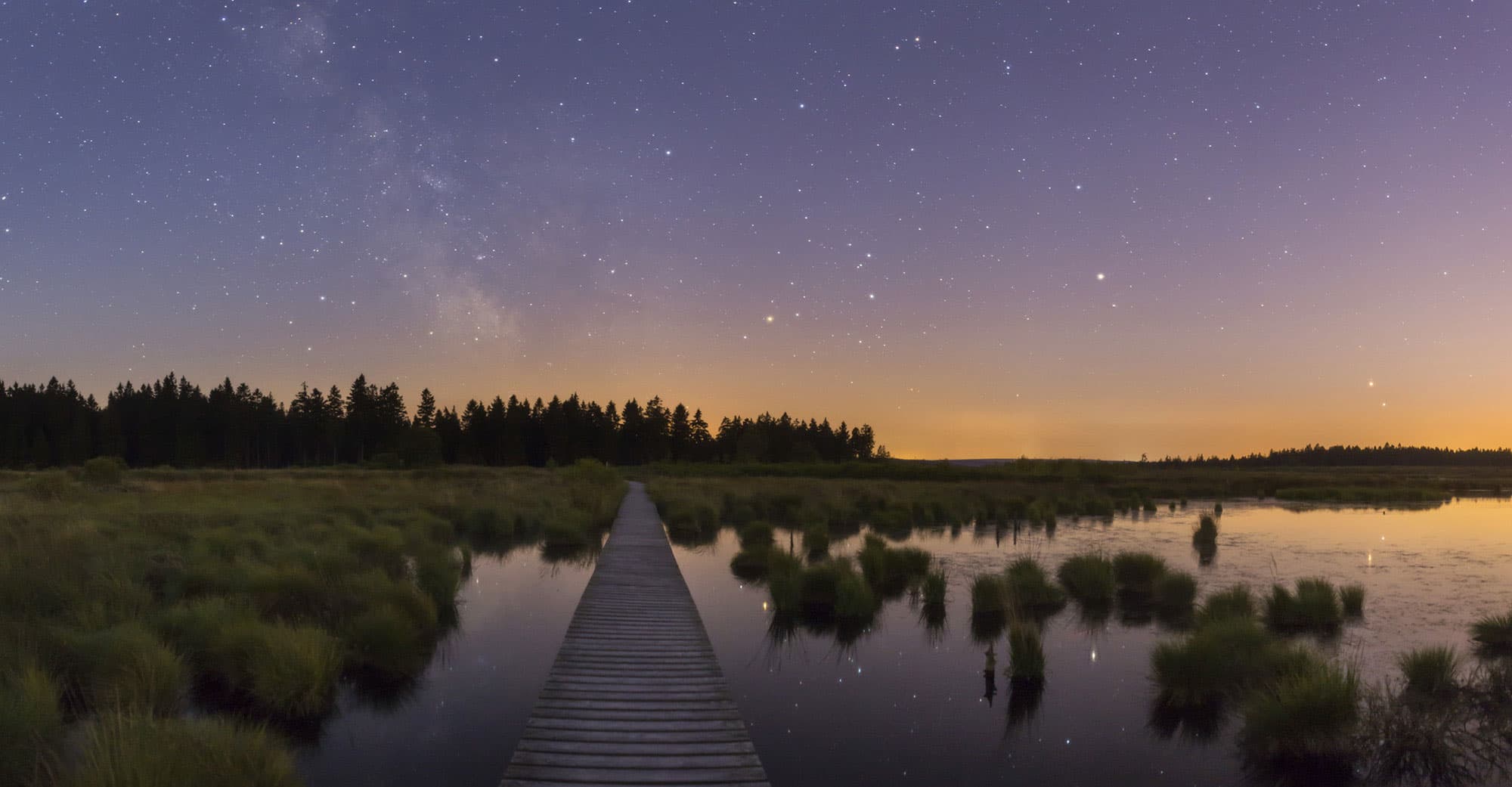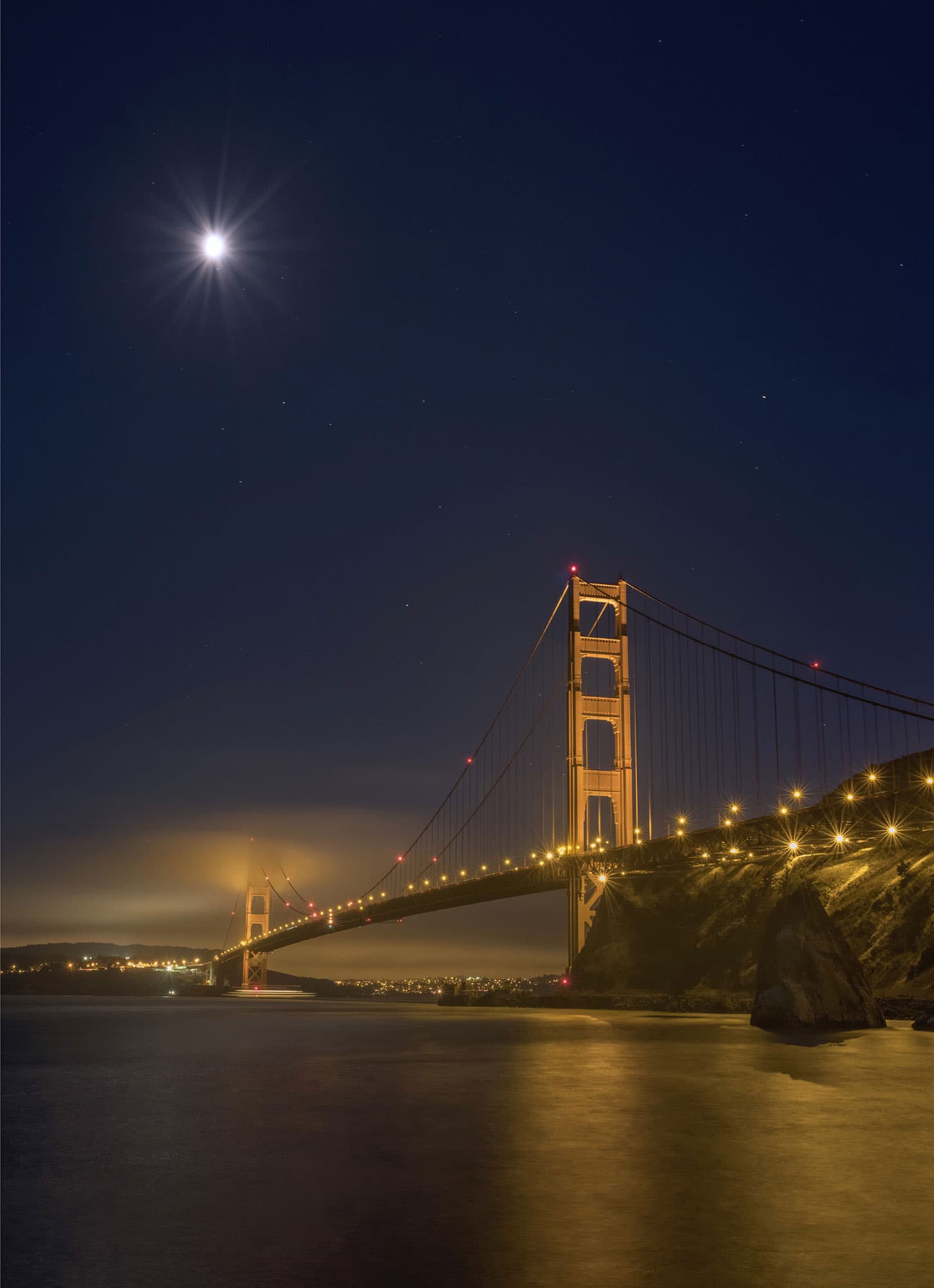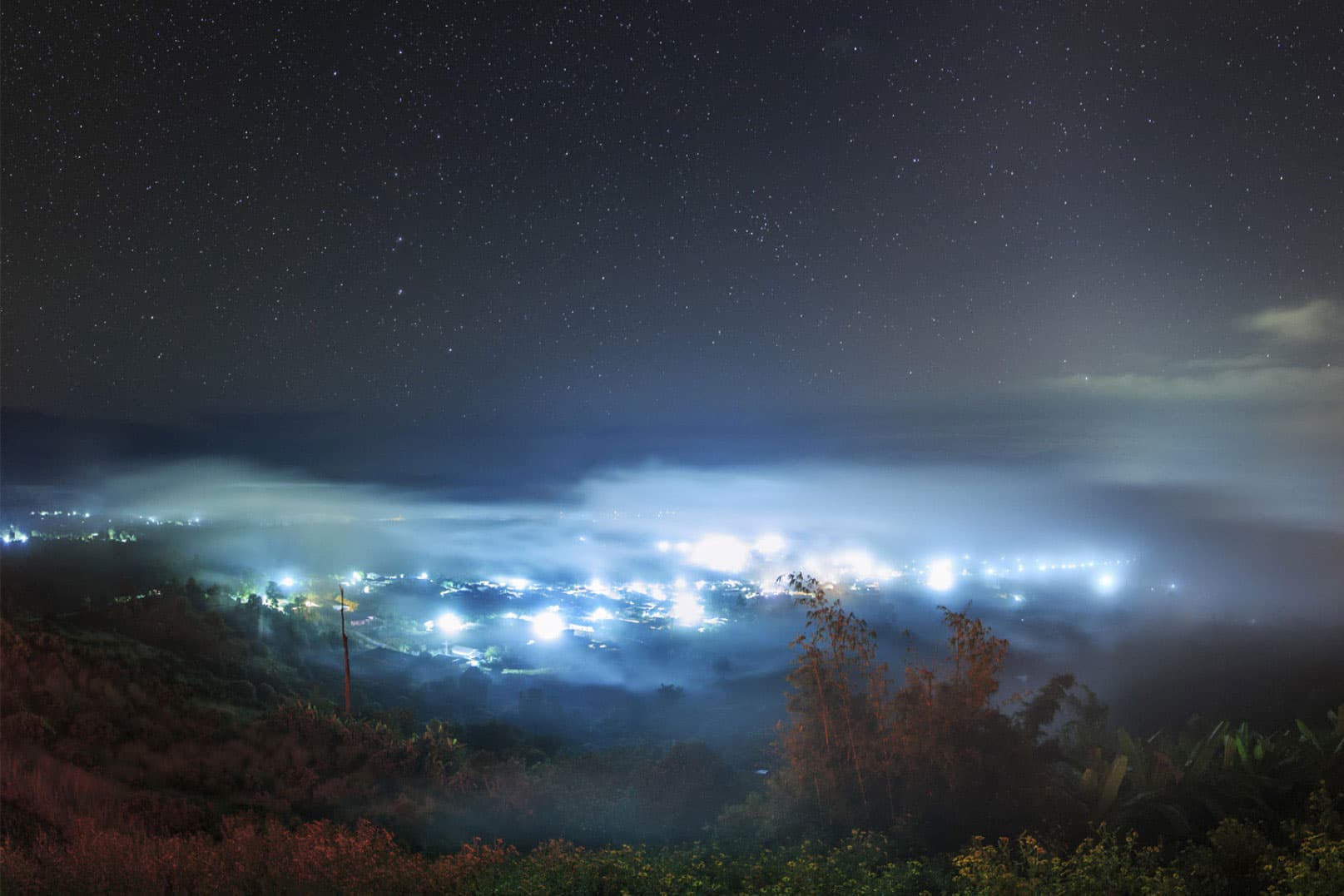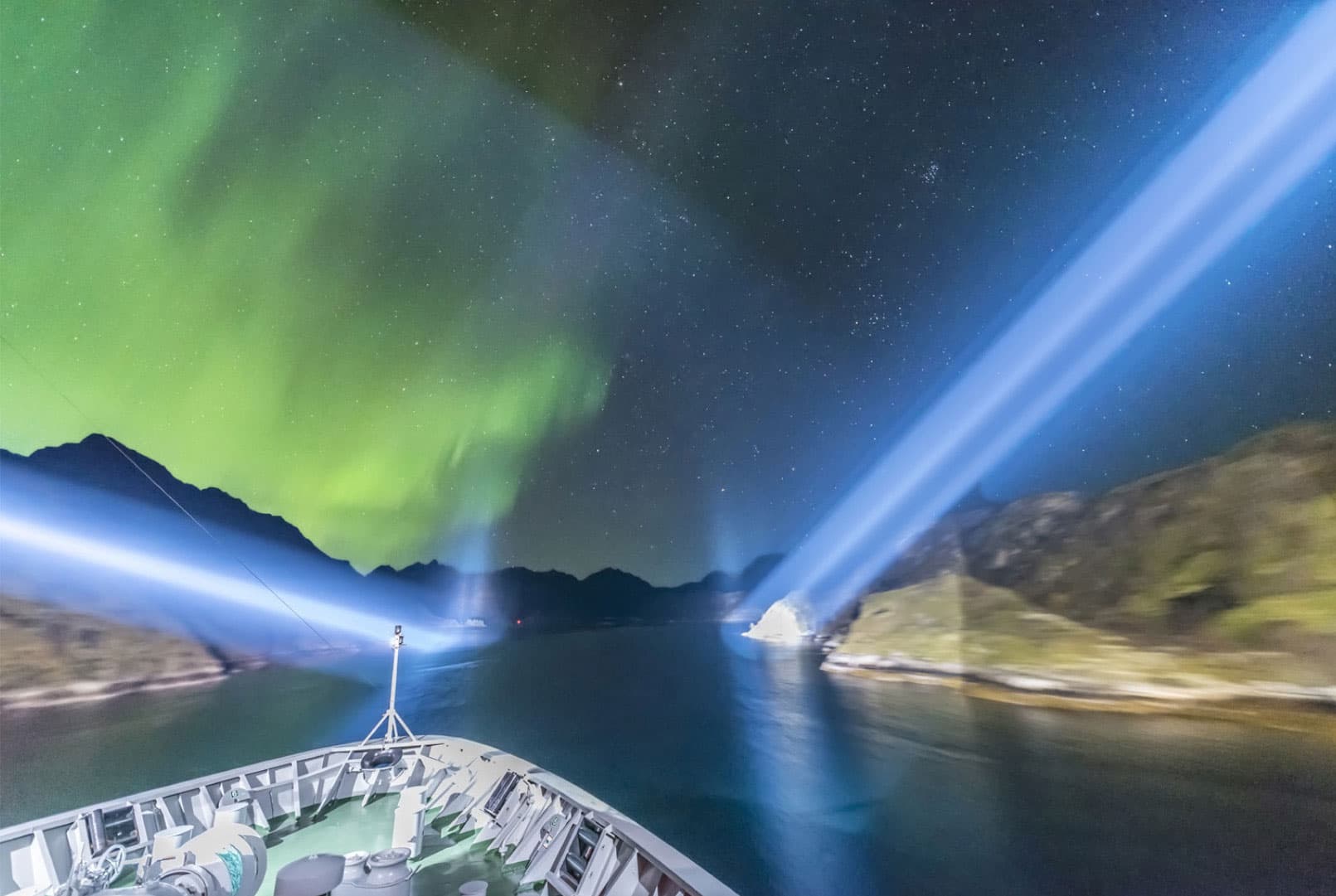CHAPTER 05
Fragile Beauty of Darkness
BY LOSING THE NIGHT SKY WE RISK THE LOSS OF A DEEP-ROOTED CONNECTION TO OUR ORIGINS.
For most of human history, the night sky has provided a useful tool for our ancestors – a natural means of keeping track of the seasons, of navigating ways across the planet and of providing the natural illumination of the full moon. With today’s technological advances such tools are no longer essential to our lives. Not only has the night sky become largely redundant but, filled as it is with reflected and refracted light – scattered rays from our overlit cities – it is not even dark enough for the Milky Way to be visible. Today, most night skies above cities are virtually empty of stars. There is a whole generation of human beings who have never seen a natural night sky. By losing the night sky we risk the loss of a deep-rooted connection to our origins. It is possible to change this by sharing concerns with others and leading our communities towards using the wide range of sky-friendly lighting that is now widely available.
Artificial light is essential for modern living, but much of it is unshielded and so scatters to the horizon and sky instead of illuminating the ground. It is this that causes a large share of light pollution. Such careless excess is not only an astronomer’s problem, but is a major waste of energy and, like any other form of pollution, disrupts ecosystems leading to adverse health problems.

Dubai UAE
The moon is the only celestial beacon that comes close to competing with the city lights in this nightscape – a situation that is all too familiar to urban skygazers. The futuristic-looking scene is dominated by the 828 m (2717 ft) tall Burj Khalifa, the tallest freestanding structure on Earth. Only the very brightest stars remain visible in this urban sky: Capella to the left of the tower and Aldebaran next to the moon.
Affecting nearly 80 per cent of the planet, artificial lighting represents one of the most significant global changes caused by human activity. Close to cities, cloudy skies that reflect streetlights are now hundreds, even thousands of times brighter than they were 200 years ago. Essential wild-life behaviours such as mating, breeding, migrating, navigating and finding food are dependent on natural night darkness and are disrupted when this is lacking. A major concern lies in the decline of insect populations due to their fatal attraction to artificial lights. Should numbers continue to decline, entire ecosystems could collapse through starvation of the species that depend on insects for food.
With the LED revolution, light pollution has entered a new phase. There is no doubt that LED lights have benefits, helping us to preserve resource. Being energy efficient, they help to create a greener planet. But a more sinister aspect of LED lights is beginning to reveal itself. A certain group of the LED lights, commercially known as cold LED, has a blue-rich light and is popular for outdoor lighting. In many cities, it has replaced the more traditional, yellow sodium streetlights. In 2016, the American Medical Association (AMA) made an official statement concerning the use of these LEDs, stating that these blue-rich LED lights are five times more disruptive to the human sleep cycle than conventional streetlighting. It seems that the human brain detects the blue light as day-time sky and so suppresses the production of melatonin, which usually increases at night-time and is essential to the deep sleep that allows the body to restore itself. An additional concern of using white LED lights lies in their intensity, or lumen output. Our eyes are not very sensitive to orange light. A white LED with the same lumen as an orange or yellow light appears much brighter to our eyes.
Hopefully, as technology advances, these issues will become obsolete. All lights have a Kelvin temperature. Temperatures of 2000–3000K are associated with yellow light, which is considered warmer and is known commercially as soft light. Temperatures of 4000–6000K are referred to as cold lights. While appropriate for dental surgeries and operating theatres, such cold lights can contribute to health issues if used for streetlights and in bedrooms. LED manufacturers now produce soft lights, too, although their use is not yet widespread in large cities. Lights with much lower temperatures (1800K) – phosphor-converted (PC) amber light – are similar to firelight and already popular in sky-friendly communities, dark sky parks and observatories. Change is underway. Chicago, one of the world’s brightest cities, has followed AMA’s guidelines to install 3000K soft LED lights for its streetlighting. This will become a model as other municipalities acknowledge the long-term hazards of cold lights.
In the coming pages Dark Sky refuges – preserved and protected places that allow visitors to experience darkness without artificial lights – are juxtaposed with urban arenas. The immediate comparison of the beauty that is hidden behind light, with the light show of urban worlds, serves to expose the loss of the silent dark sky. In the City Skies section a couple of images use digital techniques to reveal hidden stars in the urban skies. Known as ‘stacking’, such techniques involve photo sequences of many short-exposure images. We may have lost the night sky in many cities, but this method – and that of using skyglow filters to dim the dominant artificial sky brightness – enables photographers to uncover many stars. Their images offer a profound reminder of what exists beyond the vanishing curtain of light pollution.
ABOVE OUR LIGHTS
In recent decades, the nocturnal face of our planet has changed dramatically, owing to the rapidly growing levels of artificial light being sent into space. In many places – predominantly vast urban areas and industrial centres – the natural night sky is almost entirely gone, while others offer just a glimpse of what lies hidden beyond the artificial lights. This section showcases such skies, battlefields in which the starry sky interacts with its rival: light pollution. The images record scenes all over the globe – from Alpine towns in western Europe, where the night sky suddenly reappears just a short drive from the brightly lit valleys and ski resorts, to ocean waters in which thousands of fishing boats use bright attractors to light up the sea and the sky, and from a lighthouse on the coast of Brittany, France, to a barely dark sky in Belgium, one of the world’s most constantly illuminated countries. Such images reveal the impact of human activity on the natural environment in ways that daytime imagery cannot.
Perhaps the most arresting images are those that capture one-off events. At such times, unusual circumstances bring the natural sky temporarily into view, surprising local residents by revealing what has been lost in all its splendour. Incredibly, in 1994, when an earthquake that rumbled beneath Los Angeles caused a city-wide power outage just before dawn, residents called emergency centres and a local observatory to report a mysterious cloud overhead that turned out to be the band of the Milky Way, long obscured from view. In 1997, during the appearance of the great comet Hale-Bopp, the city of Milan briefly turned off the streetlights for residents to enjoy the natural wonder. The capital of Iceland, Reykjavik, occasionally turns off its lights during major aurora activity so it can be better seen from the city.

Innsbruck AUSTRIA
In this wintry scene from the Tyrolean Alps, the mountains are softly lit by moonlight, while the city’s streetlights illuminate fog hanging in the valley. The iconic section of constellation Pisces (the Fishes) is framed above the mountains, a pentagon of stars representing the ‘western’ fish. This asterism is known as the circlet, and is famous for marking the vernal equinox – the point at which the sun is located in the northern hemisphere. The highest peak visible is the Schlicker Seespitze at 2804 m (9,199 ft).

Liancourt Rocks (Dokdo) SEA OF JAPAN (EAST SEA)
This composite of time-lapse images captures the trails of stars as they set above Liancourt Rocks, a group of small islets between Korea and Japan. The bright lights of many fishing boats mask stars close to the horizon. Fishermen use intensely bright LED arrays known as fishing light attractors to lure fish and members of their food chain into their nets. Some of the strongest lights are used in squid boats, which carry more than 100 such lamps, generating as much as 300 kW of light per boat. Scientists first became aware of this night lighting of the seas in the late 1970s and early 1980s, while compiling the first satellite maps of the Earth at night.

Saarland GERMANY
A bright meteor and the setting new moon compete with the lights of small towns and a couple of power plants in this German scene. Densely populated, and with large industrial areas, Germany is one of several European countries where really dark places at night are rare. This country has one of the world’s most active professional and amateur astronomy communities, but its members have few chances of seeing the wonders of the starry sky from their own neighbourhoods.

Brittany FRANCE
Our galaxy is seen against a backdrop of lights in this image taken from Point Penmarch lighthouse on the Atlantic Ocean shores of Brittany close to midnight on the shortest night of the year. To the left of the image, thin cirrus clouds glow orange as they reflect the light pollution. To the right of the image, directly over the ocean, the clouds are dark and almost invisible. The brightest point, close to the right-hand edge, is the planet Saturn. In the centre-left, the bright summer star Altair in constellation Aquila dominates the Milky Way band.

Santorini GREECE
This exceptional night view from Oia, a town on the Greek island of Santorini in the southern Aegean Sea, surprised locals, who are usually denied such dark skies. The Milky Way, from constellations Scorpius (the Scorpion) and Sagittarius (the Archer; bottom) to Cygnus (the Swan; top), appears above candle-lit restaurants during a blackout. The island is known for its postcard views of cliff-top towns on the edge of Santorini caldera. The depths of the night sky are usually obscured by the thousands of lights in this popular tourist hotspot.

Hautes Fagnes Nature Park BELGIUM
The summer Milky Way is pictured here during moonrise over a nature reserve known as the High Fens swamps, close to the Belgian–German border. One of the most light-dominated countries in the developed world, Belgium is not known for starry skies. However, there are still a few areas from which to glimpse the beauty of the natural night sky, and this is one of them. At the centre lies the bright star Antares, at the heart of Scorpius (the Scorpion). To its right is Saturn in Libra, with Mars even further to the right, on the western horizon.

Maku IRAN
The twin volcano cones of Mount Ararat provide a dramatic backdrop for this nomad tent close to the brightly lit border between Iran and Turkey. Thanks to the high-altitude clear sky and a few kilometres distance from the border, the summer Milky Way is clearly visible above the mountain.

Lofoten Islands NORWAY
In this wide-angle panorama taken from Mount Reinebringen, a giant arc of the Northern Lights appears above the fishing village of Reine, one of the most scenic views in Norway. Unlike the fainter, elusive Milky Way, auroras are often bright enough to be visible despite the lights of villages, or even small cities.

Mount Uludağ TURKEY
Hanging above the scattered glow of nearby lights, this mountaintop vista offers a dark sky refuge thanks to the change of altitude and sky transparency. The central bulge of our home galaxy is photographed close to the 2540 m (8333 ft) barren granite summit of Mount Uludağ, overlooking the brightly lit villages near the city of Bursa.
CITY SKIES
According to the United Nations (UN), more than half of the human population lives in urban areas – a rate that is set to increase to 60 per cent by 2030, at which time one in every three people will be living in a city with at least half a million inhabitants. With a few exceptions, these are the places over which the night sky has lost the battle with light pollution. Among those cities leading the way towards a better future for urban stargazers, Tucson, Arizona, and the smaller city of Flagstaff, have streetlights that are shielded to the ground in support of the region’s astronomical observatories and to preserve some of the natural night-time environment. There are several misunderstandings about light and safety. Of course, we need some light for safety and security reasons, yet various case studies show that brighter lights in urban areas do not necessarily prevent crime. Floodlights create very bright areas, but also very dark shadows, for example. Also, when not properly shielded and pointed to the ground, bright lights can present a driving hazard, creating glare that causes a momentary lack of sight.
Artificial light is also used for purposes beyond safety. Many major cities use lighting to create an identity; cities in warm areas prefer blue-rich LED lights to create the impression of a cooler atmosphere, for example. In recent years, more than 90 per cent of Indian streetlighting has been upgraded to white LEDs with temperatures of more than 5000K. Similar developments are emerging across Southeast and eastern Asia. Still, there is a movment in the West to start action against white LEDs, with US cities that include Lake Worth, Florida, and Gloucester, Massachussetts, installing lower-temperature alternatives – not only to the relief of astonomers keen to see the night skies above their homes, but also in light of growing concerns about the health concerns related to higher-intensity LED streetlights (see here).

San Francisco, California USA
Golden Gate Bridge stretches beneath a bright moon. The most photographed bridge in the world, it spans the channel of water between San Francisco Bay and the Pacific Ocean and has been declared one of the Wonders of the Modern World by the American Society of Civil Engineers. But the area is also one of the most light-polluted nature reserves in the country. Here, a few stars appear with the help of a skyglow filter used to partly cut the light pollution.

Tehran IRAN
This unusual view shows a rich field of star trails above an ocean of streetlights and is a combination of many hundreds of continuously taken photos, each just a few seconds long for a total exposure of four hours. This technique helps to reveal stars that are otherwise hidden in the bright skyglow. The brightest trails are those of the setting moon and Jupiter. Home to about 15 million people, Tehran is seen here from Milad Tower (the tallest tower in the country). A close look at the image shows a blurring of the city lights due to the wind that caused the tower to move during the photo sequence.

Melbourne AUSTRALIA
The sky above Melbourne is devoid of stars, instead illuminated by the glow of the city. Our cosmic neighbour, the moon, is the only remaining celestial wonder in this view, photographed from the city’s 300 m (985 ft) tall Eureka Tower.

Stockholm SWEDEN
One of the strongest aurora displays of the decade competes with light pollution above Stockholm. On 17 March 2015, a massive solar storm collided with Earth’s magnetic field, producing intensely bright auroras in high latitudes. It is rare for the residents of Stockholm to see the Northern Lights in such splendour due to the city’s lights.

Shanghai CHINA
One of the world’s largest cities, Shanghai never sleeps. Parading extravagant electric signs on skyscrapers, apartments and even boats along Huangpu River, this is a city without a night sky. Most Shanghai adults will have childhood memories of fantastic starry summer nights before the local authorities began to develop the lighting in the late 1980s. Now the bright night-time view of the city attracts millions of tourists and is a large part of the city’s modern identity. In light of emerging concerns about the negative effects of excessive night lights on the human sleep cycle, Shanghai authorities have established regulations prohibiting intense lighting in residential buildings, schools, hospitals, parks, nature reserves and observatories.

London UK
The moon and a few stars can be seen on a clear night on the banks of London’s Thames River. More than two centuries have passed since the first gas-lit public streetlight was installed in the city, in 1807, replacing older oil lamps and starting a revolution in world streetlighting that has led to more efficient electric lights. In this image the nineteenth-century Tower Bridge, an iconic symbol that transports the viewer to Victorian London, is seen against the modern architecture of the Shard, a ninety-five-storey glass-clad skyscraper, completed in 2012.

Paris FRANCE
A single-exposure photograph, taken using a long telephoto lens, captures the setting moon above the Arc de Triomphe on a busy night on the Avenue des Champs-Élysées. The well-planned image shows the setting moon and a few ‘stars’ around it, but in fact, these are the aircraft-warning lights on top of the skyscrapers of the modern La Défense business district.
ENVIRONMENTAL IMPACT
Although light pollution swallows the darkness, obscuring the Milky Way, this is not the worst effect of it. Beyond any astronomer’s concerns, excessive artificial lighting affects wildlife, human health, energy, heritage and even safety. On a global average, artificial light is growing at a rate of 6 per cent per year and the night sky is brightening by around 2 per cent. Humans, birds and several other species are finding it increasingly challenging to experience night-time uninterrupted by artificial light, which disrupts the natural rhythms of mating and feeding. Among those most affected, migrating birds drift off course, turtle hatchlings are lured away from the ocean and insects are forced to hover around light sources until they die from exhaustion.
Scientists have known about the negative effects of light on birds for at least two centuries. Nineteenth-century ornithologists reported on birds killed by flying into lighthouses. Today, brightly lit buildings lure birds to their deaths at a shocking rate. Up to 1 billion birds die from building collisions each year in the United States alone. Although the vast majority of these happen in the daytime, such collisions are related to light pollution drawing migrating birds into unfamiliar urban environments. Many birds use the stars for navigation. Intense lights send bright beams into the sky, especially on moonless nights, disrupting migratory paths and causing birds to circle buildings repeatedly, dying from exhaustion if not collision. Bats and insects are also affected, as are plants, which have seen a large drop in the number of insects moving pollen at night. Light pollution can also affect day-active insects, such as bees, by disrupting their sleep cycle.
All of these problems can be solved by improving the design of lighting, by sharing concerns among other members of your community and by following a few simple steps: light only what you need, point light sources to the ground and shield them, and use warmer (yellower) lights. Timed and motion-sensor energy-saving features on outdoor lights can help, too. It does not take much to imagine the impact such actions could have on the visibility of the night sky if followed by the majority of the people living on this planet.

Brittany FRANCE
Plankton glows in the surf of this beach scene, with the Milky Way hanging in the night sky. Glowing on the horizon, like a rising sun, are the lights of a nearby town.

Arizona USA
A cloud is heavily lit by safety floodlights at the Navajo Generation Station in northern Arizona – evidence that a large amount of light energy is being wasted to the sky. One of the last remaining coal-fired power plants in the United States, the station is close to the protected nature reserves and wildlife sanctuaries of Glen Canyon and Lake Powell.

Alberta CANADA
Below a green aurora arc, a deer wanders across a wheat field, stopping briefly to look at the camera and holding still for the ten-second exposure. The landscape is illuminated by the light of a nearby town. Stars of constellation Cassiopeia and Perseus appear to the upper right of the deer with the faint autumn Milky Way. The Andromeda Galaxy (M31) is in the top-right corner of the image.

Sydney AUSTRALIA
A time-lapse image of Sydney Opera House shows ghostly trails across the sky, made by flying birds illuminated by the monument’s floodlights. Birds, both local and migrating, are attracted and trapped by intense artificial lights, resulting in changes of behaviour and often leading to their deaths. Birds trapped in floodlights often appear disoriented, circling endlessly around the source.

Tak Bai THAILAND
Covered in a blanket of low-lying cloud, Tak Bai is heavily illuminated at night by bright blue-rich LEDs from the area’s many hotels and resorts. The light obscures the view of twinkling stars overhead that, more often than not, remain visible only from outside the city.

Innsbruck AUSTRIA
Close to Innsbruck, the capital of Austria’s Tyrol region, an intense blue beam pierces the sky during an evening light show at Swarovski Crystal Worlds museum. At high altitudes such as this, the air becomes thinner. It is more transparent as a result, minimizing skyglow scattering and allowing the Milky Way to remain visible despite the city lights down below, in the valley.

Trollfjord NORWAY
A cruise ship navigates the Arctic fjord of Trollfjorden using the ship’s spotlights to illuminate the walls of the narrow fjord. Beyond the beams, green aurorae borealis dance in the clear night sky.